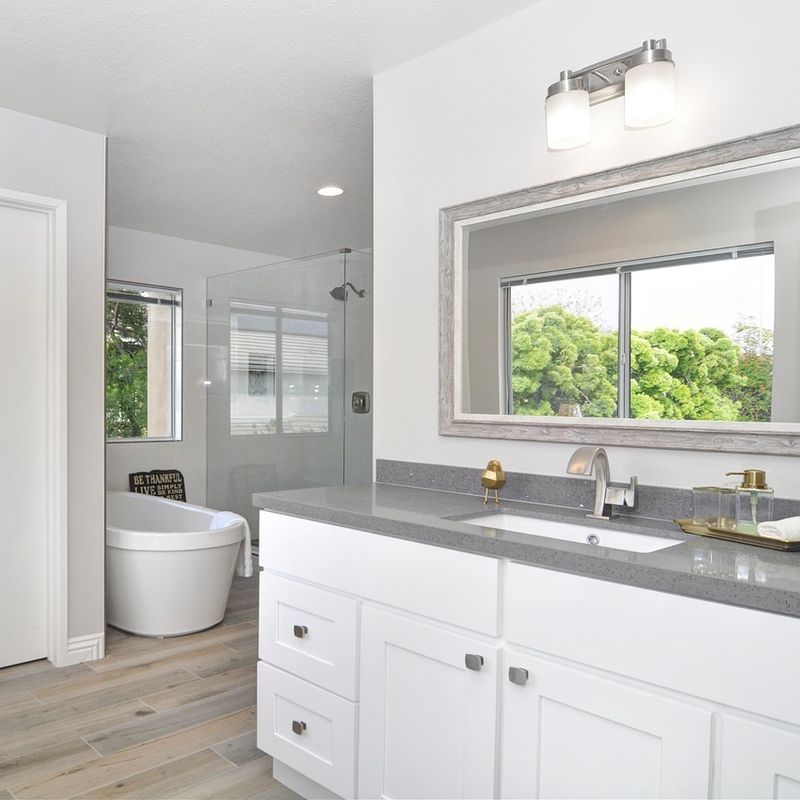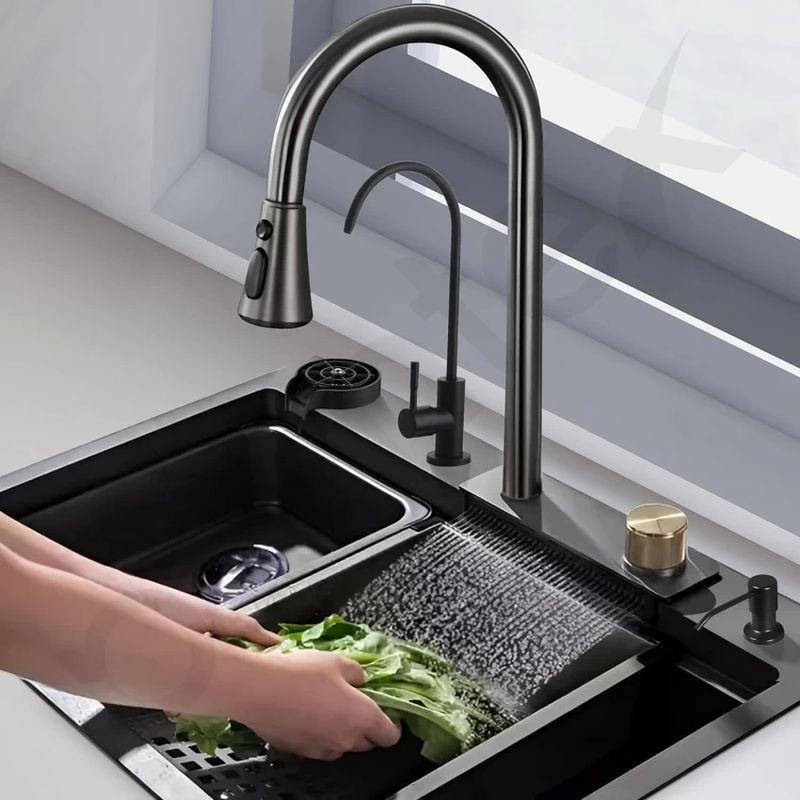 English
English
Jabra Sanitary is a sanitaryware supplier offering toilets, sinks, faucets, bathtubs, etc., at competitive prices. If you're a distributor, wholesaler, or project contractor, get a quote today!
 $23.9 Limited-time Offer
$23.9 Limited-time Offer Consignment Policy
Consignment Policy 20 Years of Experience
20 Years of Experience
When choosing the right faucet for your kitchen or bathroom, two materials often stand out: chrome and stainless steel. These materials are widely used for durability, aesthetic appeal, and functionality. But each has its unique characteristics.
In this article, we'll explore the chrome vs stainless steel faucet debate to help you make an informed decision. Stay with us as we break down the essential features, maintenance tips, and cost differences between these two popular faucet options.

Table of Contents
Chrome vs Stainless Steel Faucet: The Main Differences
Chrome Faucets: Pros and Cons
Stainless Steel Faucets: Pros and Cons
Composition and Properties Comparison: Chrome vs Stainless Steel
Aesthetics and Design Flexibility: Chrome or Stainless Steel Faucet
Strength and Durability: Chrome Versus Stainless Steel
Chrome vs Polished Stainless Steel: Maintenance and Care
Cost Analysis: Difference Between Chrome and Stainless Steel
Applications: Chrome Plated Steel vs Stainless Steel
Environmental and Health Impact: Polished Stainless Steel vs Chrome
FAQs
Final Verdict: Which Faucet is Right for Your Needs?
Chrome vs Stainless Steel Faucet: The Main Differences
When comparing chrome and stainless steel faucets, understanding their key differences is essential for making an informed decision. Let's explore the main distinctions between chrome and stainless steel faucets:
Composition and Finish
- Chrome Faucets: Chrome faucets are typically made from a base material like brass or steel, coated with a thin layer of chromium. This results in a high-gloss, reflective finish. While chrome provides a sleek and modern aesthetic, the material is a coating, which can wear over time.
- Stainless Steel Faucets: Unlike chrome, stainless steel faucets are made from an alloy that combines iron, carbon, and metals like nickel and chromium. Stainless steel faucets have a brushed or matte finish that provides a more subtle, industrial look.
Unlike chrome, stainless steel doesn't just serve as a coating. It is the material itself, offering long-lasting durability and resistance to damage.
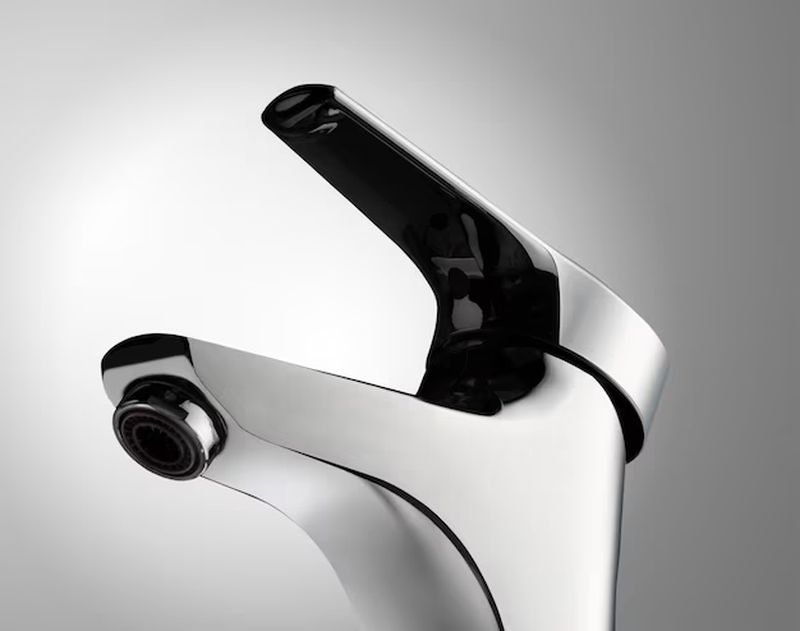
Durability and Strength
- Chrome Faucets: Chrome faucets are durable but can suffer from chipping, scratching, and tarnishing over time, especially if exposed to harsh chemicals, abrasives, or constant moisture. While chrome resists rust and corrosion to some degree, it's more vulnerable to damage than stainless steel.
- Stainless Steel Faucets: Stainless steel is known for its exceptional durability. It resists rust, corrosion, and tarnishing much better than chrome. Stainless steel faucets are more resilient to scratches and dents. Thanks to its strength and resistance to wear, stainless steel is often preferred for high-traffic or high-moisture areas like kitchens and bathrooms.
Appearance and Aesthetics
- Chrome Faucets: Chrome faucets offer a polished, shiny finish that creates a luxurious and sleek appearance. The high-gloss shine makes chrome faucets a popular choice for modern, contemporary, and even traditional designs. Chrome works well in spaces that seek a bold, reflective look.
- Stainless Steel Faucets: Stainless steel faucets have a more understated, matte finish, which gives them a clean, industrial look. Their brushed surface complements a wide variety of home styles, from minimalist designs to contemporary kitchens. Stainless steel doesn't have the same attention-grabbing shine as chrome. But its versatility makes it suitable for a range of interiors.
Maintenance and Care
- Chrome Faucets: Chrome faucets need regular cleaning to maintain their glossy appearance. They can accumulate water spots, fingerprints, and tarnishing, especially in areas with hard water. Cleaning requires careful attention to avoid damaging the chrome coating, and deep cleaning may require specialized chrome cleaners.
- Stainless Steel Faucets: Stainless steel faucets are easier to maintain due to their resistance to water spots and mineral buildup. Regular wiping down is usually sufficient to keep them looking their best. They are also less prone to tarnishing or developing visible spots from water exposure.
Cost and Long-Term Value
- Chrome Faucets: Chrome faucets are generally more affordable than stainless steel due to the less expensive manufacturing process. However, they may require more maintenance and replacements over time as the coating can wear out. This may result in a lower long-term value.
- Stainless Steel Faucets: Stainless steel faucets are initially more expensive but offer better long-term value. Their durability and ease of maintenance mean fewer repairs and replacements, making stainless steel a smart investment in the long run.
Environmental and Health Impact
- Chrome Faucets: The process of chrome plating involves the use of chemicals, which can be harmful to the environment. Chromium plating has been linked to various health concerns, including skin irritation and more severe long-term health risks when exposure is high.
- Stainless Steel Faucets: Stainless steel is much more environmentally friendly than chrome, as it is recyclable and doesn't involve the use of harmful chemicals in its production. It's considered safe for long-term use and doesn't pose the same health risks associated with chrome plating.
In conclusion, chrome faucets are generally less expensive and have a shinier finish with less durability. Stainless steel faucets are stronger, more durable, and more resistant to corrosion with a higher price tag.
Chrome Faucets: Pros and Cons
Like any material, chrome faucets come with both advantages and disadvantages. Let's examine the pros and cons of chrome faucets to help you determine if this finish is right for your space.
Pros of Chrome Faucets
1. Shiny, Attractive Appearance
Chrome faucets are known for their glossy, mirror-like finish. This high-shine look gives them a sleek, modern appeal that suits contemporary, minimalist, and even traditional interior designs.
The reflective surface can add a luxurious feel to your bathroom or kitchen, making it an eye-catching feature.
2. Affordability
Chrome faucets are often more budget-friendly than stainless steel options. The manufacturing process for chrome is less expensive. They are an attractive option if you're looking to save money on fixtures without compromising on style.
3. Corrosion Resistance
Chrome has a protective layer that helps resist corrosion and rust. It provides a degree of protection against water damage, especially in areas with lower humidity or less exposure to water.
4. Easy to Find
Chrome faucets are widely available and come in various styles, making them easy to find in most home improvement or online stores.
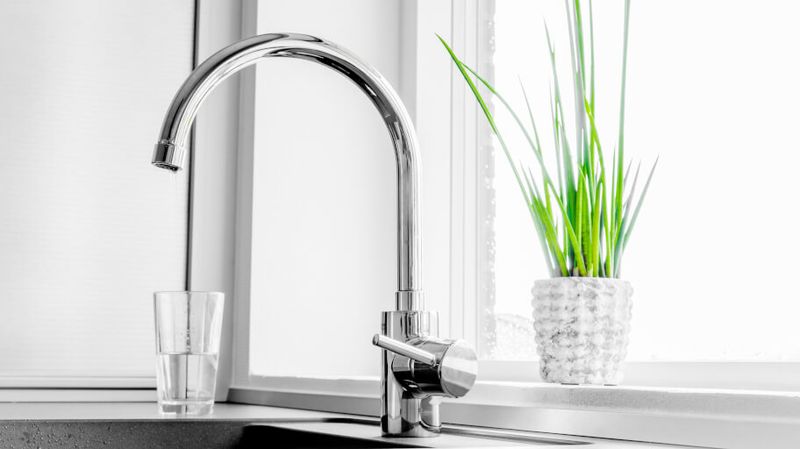
Cons of Chrome Faucets
1. Susceptible to Scratching and Chipping
One of the main drawbacks of chrome faucets is that the chrome coating can scratch, chip, or peel over time, especially in high-use areas. If the faucet gets scratched, the underlying material may become exposed, leading to dull spots and visible damage.
This can be especially true if abrasive cleaning tools or harsh chemicals are used, which can wear down the coating.
2. Frequent Maintenance
Chrome faucets require regular maintenance to maintain their polished appearance. Over time, they can accumulate water spots, fingerprints, and mineral deposits, especially if you live in an area with hard water.
3. Not as Durable as Stainless Steel
While chrome is a durable coating, it's not as robust as solid stainless steel. Over time, repeated exposure to moisture, cleaning, and wear can cause the chrome coating to deteriorate, leading to corrosion beneath the surface.
4. Prone to Tarnishing
Chrome faucets can tarnish if they're exposed to harsh chemicals or abrasive cleaning methods. This can cause the faucet to lose its luster and become dull or cloudy.
5. Environmental Concerns
The process of applying chrome plating involves toxic chemicals that can have negative environmental impacts. While the faucets themselves can last for years, the chrome plating process can release hazardous materials.
Stainless Steel Faucets: Pros and Cons
Stainless steel faucets are a popular choice for those who prioritize durability, strength, and long-term value. Let's take a look at the pros and cons of stainless steel faucets:
Pros of Stainless Steel Faucets
1. Corrosion and Rust Resistance
One of the standout features of stainless steel faucets is their corrosion resistance. Unlike chrome faucets, stainless steel is a naturally rust-resistant material.
It's made with nickel and chromium. It forms a protective layer that shields the faucet from the damaging effects of moisture and water exposure.
2. Low Maintenance
Stainless steel faucets are incredibly easy to maintain. They are less likely to develop water spots or mineral buildup compared to chrome faucets, especially in areas with hard water.
With just a quick wipe-down using a soft cloth, stainless steel faucets maintain their sleek, brushed appearance, requiring little to no additional care.
3. Long Lifespan
Stainless steel faucets are designed to last longer than chrome faucets. Due to their solid construction and superior resistance to damage, they are less likely to show signs of wear and tear.
So they can stay in good condition for many years without the need for replacement.
4. Sleek and Modern Appearance
Stainless steel faucets typically have a brushed or matte finish, which gives them a modern, clean look. Their understated appearance blends well with many interior design styles, including contemporary, industrial, and minimalist decor.
5. Eco-Friendly and Safe
Stainless steel is a highly sustainable material. It is recyclable and does not release harmful chemicals into the environment during production or use.
Additionally, it does not pose the same health risks that chrome can, making it a safer and more environmentally responsible option.

Cons of Stainless Steel Faucets
1. Higher Initial Cost
One of the main drawbacks of stainless steel faucets is their higher initial cost. Stainless steel is a more expensive material compared to chrome, which makes the faucets more costly upfront.
2. Prone to Fingerprints and Smudges
One minor downside of stainless steel faucets is that their brushed finish can sometimes show fingerprints and smudges. While this is less noticeable than water spots on chrome, it may still require occasional wiping to keep the faucet looking clean.
3. Not as Shiny as Chrome
Some people may prefer the high-gloss, shiny appearance of chrome faucets, and may not find stainless steel as visually appealing due to its matte finish.
Stainless steel faucets can lack the flashy appeal of chrome. So if you're looking for a faucet that stands out and sparkles, you might miss the reflective quality of chrome.
4. Can Be Prone to Scratches in Certain Conditions
While stainless steel is highly resistant to damage, it is not completely scratch-proof. In high-use areas or environments with frequent heavy contact, scratches can still occur.
5. Require Specific Cleaning Products
While maintenance is generally easy, using abrasive cleaners or harsh chemicals can damage the surface of stainless steel. It's important to use the right type of cleaner—mild detergents or specialty stainless steel cleaners—to avoid scratching or dulling the finish.
Composition and Properties Comparison: Chrome vs Stainless Steel
Understanding the composition and properties of chrome and stainless steel is crucial when deciding on the best faucet material for your needs. Let's take a deeper look at how these materials differ when it comes to physical and mechanical properties:
Physical Properties
Chrome Faucets: Chrome is a coating that provides a glossy, mirror-like finish. It is applied to a base material like brass or steel. While chrome is corrosion-resistant, the layer can wear off with time, especially if the faucet is exposed to harsh chemicals or abrasive cleaning methods.
Stainless Steel Faucets: Stainless steel, being an alloy, is much more robust. It has a solid structure that resists rust, corrosion, and tarnishing. The metal's composition of nickel, chromium, and iron gives it strength, making it more resistant to extreme weather conditions. So stainless steel is a top choice for durability.
Mechanical Properties
Chrome Faucets: Chrome's thin coating can make it vulnerable to chipping and scratching, especially in high-use areas like kitchen sinks. However, it's still highly resistant to rust and corrosion in general.
Stainless Steel Faucets: Stainless steel is exceptionally strong and maintains its structural integrity over time. It has a high resistance to scratches and dents, which makes it ideal for long-term use in busy environments like kitchens and bathrooms.
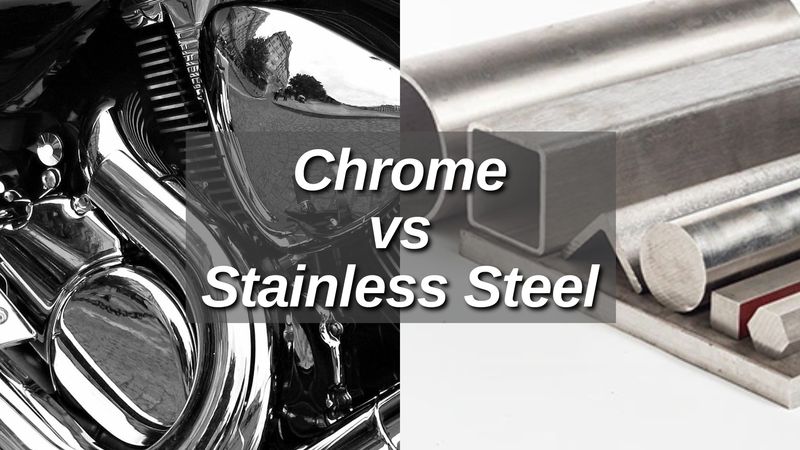
Aesthetics and Design Flexibility: Chrome or Stainless Steel Faucet
One of the key differences between chrome and stainless steel faucets is their appearance and design flexibility. Let's look at how each material contributes to the overall look and feel of a room:
The Appearance
Chrome Faucets: The polished, shiny finish of chrome faucets can add a touch of sophistication and luxury to any space. Their high-gloss appearance makes them stand out and can create a striking focal point in a room.
Stainless Steel Faucets: Stainless steel faucets feature a more subtle, muted finish. The brushed texture gives it a clean and modern feel. Stainless steel complements industrial, minimalist, and modern designs, offering a quieter aesthetic compared to chrome.
Versatility in Home Designs
Chrome Faucets: Chrome's high-gloss shine can make it difficult to pair with certain home designs, especially if the style is more rustic or minimalist. However, it works well in modern, contemporary, and luxury spaces.
Stainless Steel Faucets: Stainless steel's neutral, matte finish makes it versatile enough to fit into a wide range of design schemes, from industrial kitchens to modern bathrooms. It blends well with many materials and can complement different color palettes seamlessly.

Strength and Durability: Chrome Versus Stainless Steel
When considering a faucet's longevity, strength and durability are key factors. Let's compare how chrome and stainless steel measure up in terms of corrosion resistance, vulnerabilities, and lifespan.
Corrosion Resistance
Chrome Faucets: While chrome provides a protective coating that prevents corrosion, it is still more susceptible to damage than stainless steel. Over time, the chrome layer can degrade, leading to corrosion if exposed to harsh conditions.
Stainless Steel Faucets: Stainless steel is highly resistant to corrosion due to its composition of chromium, which forms a protective layer on the surface. It's ideal for areas with high humidity or frequent exposure to water, such as kitchens and bathrooms.
Vulnerabilities
Chrome Faucets: The main vulnerability of chrome faucets is that the coating can scratch, peel, or chip over time, especially if exposed to abrasive cleaners or rough handling.
Stainless Steel Faucets: While stainless steel is highly durable, it can still develop surface scratches and dents. However, it's much less likely to experience the kind of visible damage that chrome faucets are prone to.
Lifespan
Chrome Faucets: Chrome faucets generally have a shorter lifespan than stainless steel. With frequent use, the shiny finish can dull, and the protective layer can wear off.
Stainless Steel Faucets: Stainless steel faucets are built to last. They resist rust, corrosion, and staining, making them ideal for long-term use. The metal's strength ensures that it can handle wear and tear.
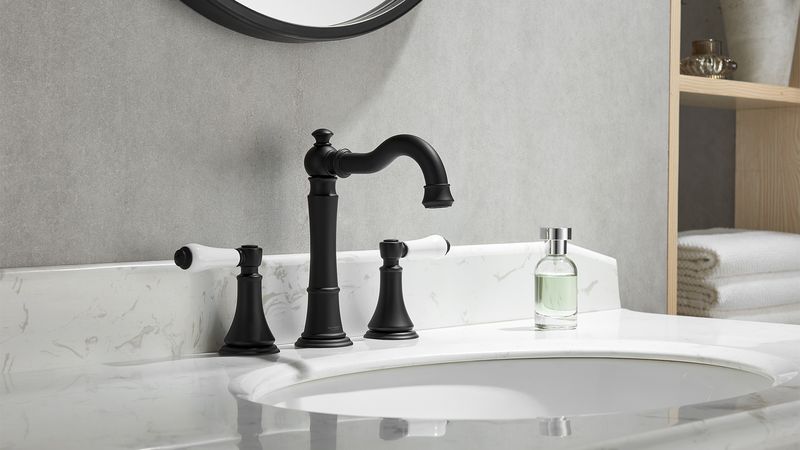
Chrome vs Polished Stainless Steel: Maintenance and Care
Maintaining the cleanliness and appearance of your faucet is key to its longevity. Here's how you can take care of chrome and stainless steel faucets:
Cleaning Methods
Chrome Faucets: Chrome faucets require regular cleaning to maintain their glossy finish. A gentle, non-abrasive cleaner is recommended to prevent scratching the surface. You should avoid using harsh chemicals or scrubbing tools that could damage the chrome layer.
Stainless Steel Faucets: Stainless steel is much easier to maintain than chrome. You can clean it with a mild detergent and water, and a soft cloth or sponge will suffice.
Daily Care
Chrome Faucets: Regularly wiping down your chrome faucet after each use can help prevent water spots and tarnishing. Use a soft cloth to avoid scratches.
Stainless Steel Faucets: Stainless steel is more forgiving. Simply wiping it down with a cloth after use is often enough to keep it looking its best.
Deep Cleaning
Chrome Faucets: For a more thorough clean, you can use specialized chrome cleaners or polishers to restore its shine. However, be cautious about overusing these products, as they can damage the surface.
Stainless Steel Faucets: Deep cleaning stainless steel faucets is relatively simple. Using a mixture of baking soda and water can remove stubborn stains without causing harm. Stainless steel cleaners can also help restore its luster.
Cost Analysis: Difference Between Chrome and Stainless Steel
Understanding the cost differences between chrome and stainless steel faucets is essential when making a purchase decision. Let's break down the costs of both materials in terms of initial investment and long-term value.
Initial Investment (Cost of Materials and Fabrication)
Chrome Faucets: Chrome faucets are generally more affordable than stainless steel. The manufacturing process for chrome is less expensive since it involves applying a thin layer of chrome to a base material like brass or steel.
Stainless Steel Faucets: Stainless steel faucets tend to be more expensive due to the material itself. Stainless steel is more durable and requires more complex manufacturing, which drives up the initial cost.
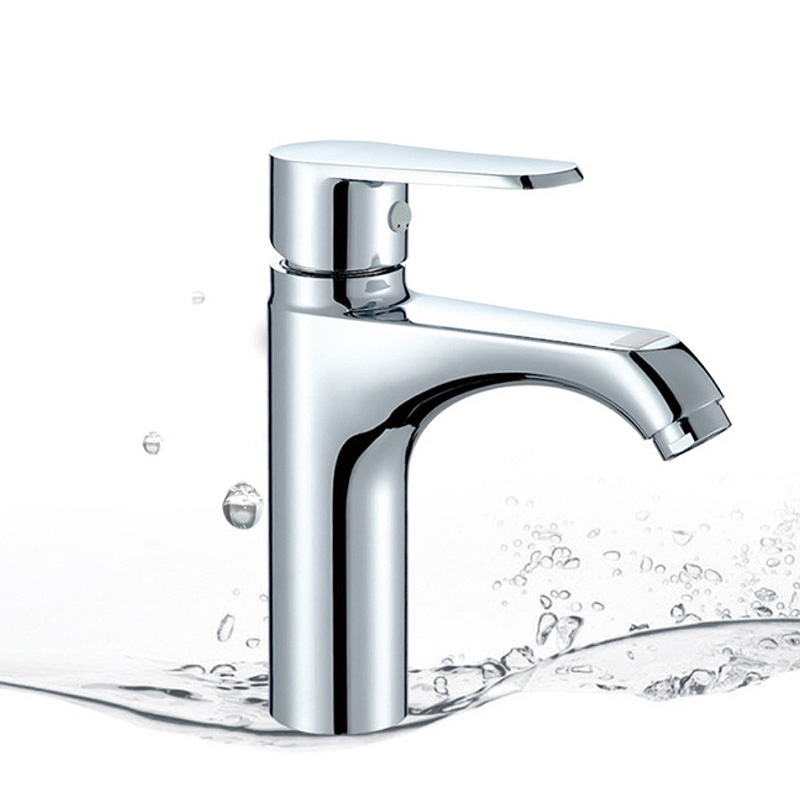
Brass Single-Hole Chrome Bathroom Faucet
The Brass Single-Hole Chrome Bathroom Faucet EF8081 offers a sleek and durable design, perfect for any modern bathroom. Crafted from high-quality 59 brass with a weight of 1 kg, this chrome single hole faucet provides exceptional purity and structural integrity.
Long-Term Value (Maintenance Expenses and Replacement Costs)
Chrome Faucets: While chrome faucets may be cheaper initially, their long-term value may be lower due to the maintenance costs and shorter lifespan. Chrome faucets are more likely to need replacement or re-coating after several years of use.
Stainless Steel Faucets: Stainless steel faucets have a higher initial cost, but they provide better long-term value. Their durability and ease of maintenance mean you'll spend less on repairs, replacements, or coatings.
Applications: Chrome Plated Steel vs Stainless Steel
Both chrome-plated steel and stainless steel faucets have various uses beyond just home kitchens and bathrooms. Let's look at where these materials are commonly used in different industries:
Automotive Industry
Chrome-Plated Steel: Chrome-plated steel is widely used in the automotive industry, particularly for trim pieces, bumpers, and other components that require a shiny, protective finish.
Stainless Steel: Stainless steel is used in automotive parts that need strength, corrosion resistance, and durability, such as exhaust systems, engine parts, and body panels.
Aerospace Sector
Chrome-Plated Steel: The aerospace sector often uses chrome-plated steel for parts that need a reflective surface and protection from corrosion.
Stainless Steel: Stainless steel's strength and resistance to high temperatures make it a critical material in aerospace for structural components and engine parts.
Manufacturing and Machinery
Chrome-Plated Steel: Chrome-plated steel is used in various machinery parts, such as shafts and gears, where a glossy, durable finish is important.
Stainless Steel: Stainless steel's superior strength makes it ideal for high-stress machinery parts, tools, and components.
Energy Industry
Chrome-Plated Steel: Chrome plating is often used in energy-related equipment like pipes and valves to provide corrosion resistance.
Stainless Steel: Stainless steel is essential for building equipment that must endure extreme conditions, such as offshore drilling rigs and power plants.

Environmental and Health Impact: Polished Stainless Steel vs Chrome
Finally, we need to consider the environmental and health impacts of these materials. Both chrome and stainless steel have different effects on our health and the environment.
Sustainability
Chrome: Chrome plating involves the use of harmful chemicals and processes that can have negative environmental impacts. Disposal of chrome-plated materials can pose a risk to ecosystems and human health.
Stainless Steel: Stainless steel is a more sustainable option. It is recyclable, durable, and doesn't require toxic chemicals in its production. It is a better choice for environmentally conscious consumers.
Health Implications
Chrome: Prolonged exposure to chrome, especially hexavalent chromium, can pose health risks. This form of chromium is toxic and can cause skin irritation, lung problems, and other health issues.
Stainless Steel: Stainless steel is generally considered safe and does not pose the same health risks as chrome. It is non-toxic and hypoallergenic, making it a safer choice for faucets and food-related applications.
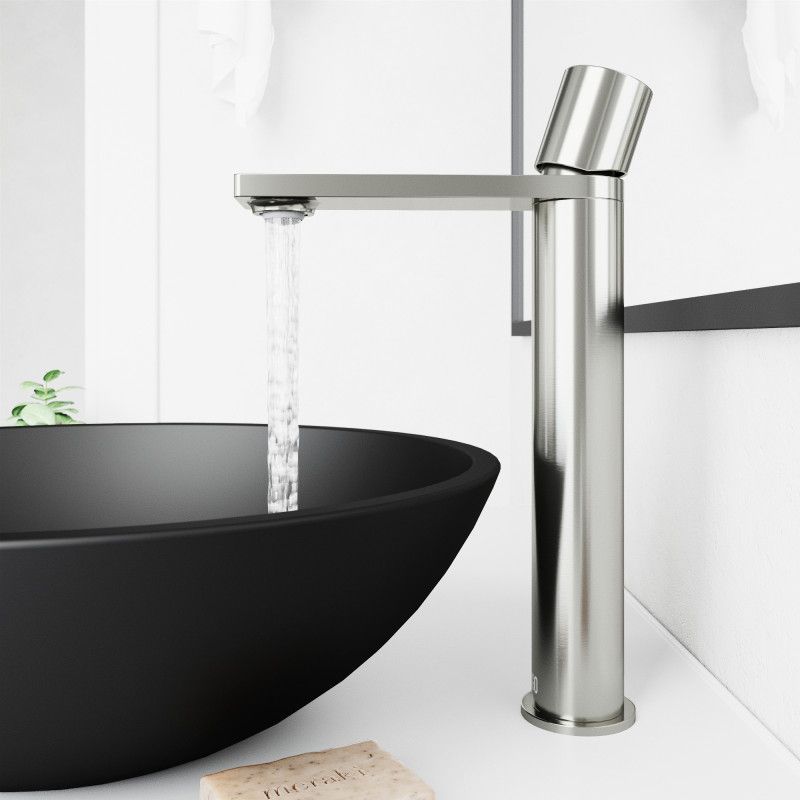
FAQs
What is the best faucet finish for hard water?
Stainless steel is often the best option for hard water areas because it resists water spots and mineral buildup better than chrome.
How long do kitchen faucets last?
A typical kitchen faucet can last anywhere between 15 to 20 years, depending on the quality of the faucet, how well it's maintained, and the water hardness in your area.
How to remove rust from chrome faucet?
Use a mild abrasive, like baking soda paste, or a specialized chrome cleaner to gently remove rust.
Are chrome faucets hard to keep clean?
Chrome faucets can be more challenging to maintain than stainless steel. They tend to show water spots and require regular polishing to maintain their shine.
Do stainless steel and chrome go together?
Yes. Many modern kitchens and bathrooms incorporate both materials for a stylish, mixed-metal look.
Final Verdict: Which Faucet is Right for Your Needs?
Ultimately, the choice between chrome and stainless steel faucets depends on your personal preferences, budget, and long-term needs. If you're looking for a shiny, elegant look and are willing to invest in regular maintenance, chrome might be the way to go.
However, if you prioritize durability, ease of maintenance, and a longer lifespan, stainless steel is likely your best bet.
Ready to make a decision? If not, you can contact Jabra Sanitary for the final verdict. No one understands faucet materials like we do—choose the best chrome or stainless steel faucet for you.









